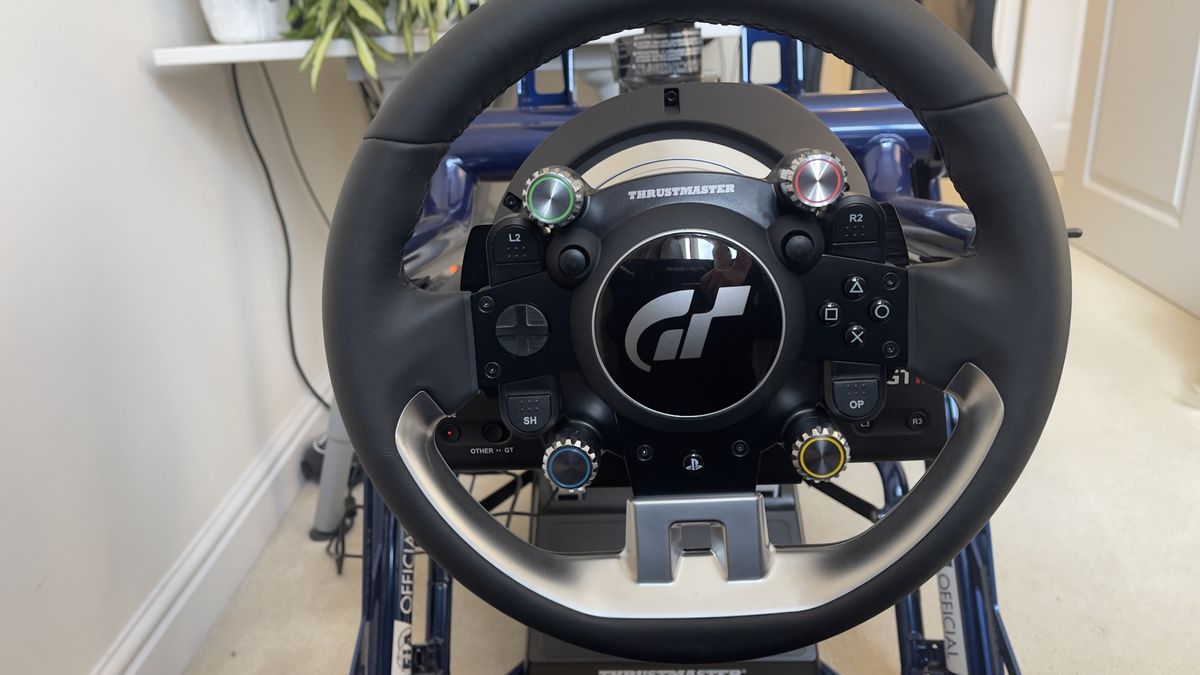Products You May Like
Thrustmaster T-GT II: One-minute review
The mid-range of the best racing wheels is a tricky space where competing technologies vie for space, but Thrustmaster makes a compelling argument with a wheel, wheelbase, and pedals bundled for $799.99 / £699.99.
That’s a lot pricier than Logitech’s all-conquering G923 bundle, but the advantages are clear: a quick-release system that lets you install new wheels and a particularly refined force feedback sensation that feels somewhere between traditional belt-driven and direct-drive servos. The underlying tech is still belt-driven, but it’s been engineered so carefully to deliver its considerable power smoothly and convincingly, with fewer of those notchy, snappy moments you usually get with belt-driven motors.
The controls on the wheel feel premium and long-lasting, particularly the four notched dials, which are really handy for mapping traction control, brake balance, engine modes, and fuel maps. Being a licensed wheel for Gran Turismo 7 and pitched as one of the best PS5 racing wheels, the giant ‘GT’ logo at the center of the wheel won’t be to everyone’s taste, and the overall look of the wheel – and particularly the plasticky pedal base – does this bundle a disservice. Despite the high volume of plastic and a slightly ‘gamey’ look this is up to the task for serious sim racers, who’ll appreciate the ability to fit different wheels for different disciplines.
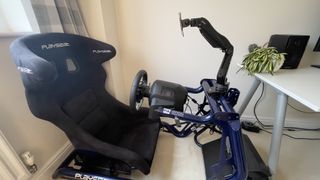
Thrustmaster T-GT II: Price and availability
- $799.99 / £699.99 (around) AU$1,221.99
- Sits between entry-level force feedback and direct drive wheels
- Pricier but more feature-laden than a G923
It might look like a lot of money for a non-direct drive wheel at first glance, but it all makes sense after a few hot laps. The wiser money would be spent investing in a Fanatec Ready2Race McLaren bundle for the same price, but ongoing stock availability issues make that a tricky purchase as of summer 2024.
Thrustmaster T-GT II: Specs
| Price | $799.99 / £699.99 |
| Weight | 29lbs / 13,150g |
| Peak torque | Approx. 6Nm |
| Features | Quick release wheel, three-pedal base |
| Connection type | USB-A |
| Compatibility | Playstation 5, PC |
| Software | Thrustmaster Control Panel |
Thrustmaster T-GT II: Design and features
- Looks inspired by Gran Turismo
- Bulky servo
- Feels better than it looks
There’s a line in the sand in sim racing gear. On one side, Moza and Fanatec have decided to take their visual cues directly from motorsport, rather than gaming peripherals. Their wheels and pedals look like they’ve been crowbarred out of a racing car and attached to your desk. On the other, Logitech and Thrustmaster – who also make a broad range of gaming peripherals besides wheels – have a design philosophy that sits closer to gaming mice, gaming keyboards, and gaming headsets.
Who’s right? That’s totally subjective, of course. To me the less automotive appearance of the T-GT II comes off as a bit less premium than this bundle really is, particularly the plastic casing around the servo and on the pedal base, which really doesn’t look like it should be part of an $800 / £700 racing bundle.
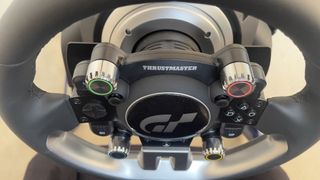
However, these aesthetic missteps have no bearing on the performance of either the wheels or pedals, and since the wheel’s detachable, you could replace it with a more motorsport-inspired option like Thrustmaster’s Ferrari SF100 if you like.
The wheel itself is finished in nicely stitched pleather which makes for a grippy surface while you’re racing, with no need for racing gloves, unlike pricier Alcantara-finished wheels which can get a bit crispy over time if you subject them to your palm sweat.
Being a PlayStation-compatible wheel as well as PC, all the DualSense controller’s inputs are mapped onto input buttons on the wheel itself, including two tiny analog sticks. Four dials complete the input array on the wheel face, and satisfyingly chunky paddle shifters with magnetic actuation sit at the rear. All the buttons feel substantial and the dials in particular are a joy to use, notched and manufactured from aluminum for a lovely weighty feel. The analog sticks and d-pad feel flimsy by comparison, but I didn’t find myself using them – there are plenty of other buttons to map important inputs to.
Those four dials are the stars of the show. They’re placed conveniently within thumb’s reach, and having four of them is especially useful in games like Assetto Corsa Competizione (ACC), where I find myself adjusting traction control and brake bias frequently from lap to lap as track conditions and tire wear levels evolve. It’s rare to find more than two dials on wheels at this price, and I find myself missing having four now when I use other wheels.
The pedals don’t feature a load cell design, so you can’t swap out the cells to adjust the resistance, but they are built with convincing resistance per pedal. The brake is particularly well-judged for stiffness, and you can add an additional rubber stay for some increased resistance right at the end of its path of travel.
Thrustmaster T-GT II: Performance
- Powerful but smooth force feedback delivery
- Easy to calibrate
- Recognized by most racing games
Let’s quickly state the obvious: although this wheel was designed in collaboration with Gran Turismo developer Polyphony Digital and bears the PlayStation racer’s branding, it’s compatible across pretty much every racing game you throw at it on PS5 or PC. Assetto Corsa Competizione and F1 24 had profiles ready to go as soon as I loaded them up with the T-GT II connected, and I had no problems setting it up in The Crew Motorfest or Forza Horizon 5. You’d expect pretty much universal support across racing titles in 2024, and this wheel delivers it.
What discerns the force feedback on this wheel from the perennially popular Logitech G923, and indeed Thrustmaster’s own cheaper wheels, is the smoothness and detail of its feedback. It’s a subtle difference, not quite akin to the jump from belt-driven to direct-drive wheels, but it’s particularly noticeable in demanding sims like Assetto Corsa Competizione, whose force feedback implementation is absolutely exemplary. You can feel when your platform’s on the very limit, and rather than getting those snappy moments that feel like something inside the servo has let go, the T-GT II’s wheel stays smooth even when it’s doling out extremely forceful feedback.
In some instances, it feels too strong. In most games, the centering spring strength needed some adjustment using a combination of in-game settings and Thrustmaster’s own Control Panel software, and in ACC in particular I ended up reducing it down to as little as 20 per cent in order to find a realistic feel. However, once you do get a convincing feel dialed in, the detail and fidelity you feel through your hands is extremely impressive.
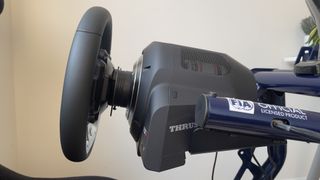
What about Gran Turismo 7? As you’d expect, it’s excellent with this wheel. Polyphony’s is a particularly weighty handling model in the first place, and it’s perfectly tuned to this wheel when you connect it to your PS5.
However, the fact remains that direct-drive wheel bundles are available at the same price point, and that makes life difficult for this particular wheel. It’s demonstrably better than its belt-driven contemporaries from other manufacturers, and lower down the Thrustmaster range. But it’s no match for a setup built around Fanatec’s CSL direct drive servo. Cheaper Fanatec bundles than the T-GT II generally feature an inferior two-pedal set, but the Ready2Race McLaren bundle uses a three-pedal base with load cells, and the McLaren GT-style wheel feels more luxurious and automotive than this model.
The best mandate for opting for this instead of a Fanatec bundle, then, is that you play primarily on PS5, put in a lot of hours with Gran Turismo 7, and want to use the same setup for some PC sim racing.
Should I buy the Thrustmaster T-GT II?
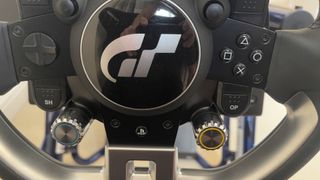
Buy it if…
Don’t buy it if…
Also consider…
If the Thrustmaster T-GT II isn’t quite what you’re after, alert yourself to these other candidates.
| Row 0 – Cell 0 | Thrustmaster T-GT II | Thrustmaster T248 | Logitech G923 |
| Price | $799.99 / £699.99 (around AU$1,211.99) | $129.99 / £129.99 (around AU$249) | $99.99 / £89.99 (around AU$196) |
| Weight | 29 lb / 13,150 g | 6 lb / 2,700 g | 6.8 lb / 3,100 g |
| Peak torque | Approx. 6Nm | 3.5Nm | 2.3Nm |
| Features | Detachable wheel, three-pedal base | Three FF modes, on-wheel display, three-pedal base | Trueforce, LED RPM display, three-pedal base |
| Connection type | USB-A | USB-A | USB-A |
| Compatibility | PlayStation 5, PC | PlayStation 5, PlayStation 4, PC | PC & Xbox or PC & PS5 |
How I tested the Thrustmaster T-GT II
- Over a month of regular use during testing
- Used with PC and PS5
- Racing sims and arcade titles tested
We installed the T-GT II into our Playseat and used it as our daily driver in Assetto Corsa Competizione, Gran Turismo 7, The Crew Motorfest, and Forza Horizon 5 for a month of virtual racing on both PC and PlayStation 5. You don’t want to know how much of a hassle it was to get the rig downstairs in front of the PS5…
First reviewed August 2024.
